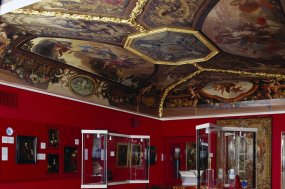|
|
|
|
The oldest generations of the IJsselstein family
The children of Dirck Jansz. Beijen |
Dirck Beijen, the main character of the previous page, and his wife Jannigchen had six children: Jan, Harmen, Lijntgen, Belichgen, Gijsbert and Hillichgen. As we have no baptismal registers from that time, the sequence of the children is not certain. Three of them are discussed here.
Jan Beijen Jan Beijen (4.1) married in 1615 in Utrecht Maria van Zijll. Jan was a flax merchant. Jan Beijen (4.1) married in 1615 in Utrecht Maria van Zijll. Jan was a flax merchant.
Jan and Maria lived in the centre of Utrecht, near the old canal called Oudegracht. The map shows the place of their house. The autumn of 1624 was disastrous for the family. Jan died in September, and Maria and one of their two children died in November, both of bubonic plague. The other child, Jacob (5.2), survived and grew up with his family in IJsselstein. He married a certain Maria Wep and had some children. In later years this little branch became extinct. Belichgen BeijenBelichgen Beijen (4.4), who was also called Belia or Sibilla, married in 1626 in Utrecht Cornelis van der Schuer. At first Cornelis was a process-server in one of the government offices in The Hague. Afterwards he studied law at the Leiden University and was a solicitor in The Hague. After 1650 Cornelis en Belichgen moved to Maastricht. They probably died in the Maastricht area in later years.
Gijsbert Beijen All present members of the IJsselstein family descend from Gijsbert Beijen (4.5). He was a 'chirurgijn' (a medical practitioner who was not educated at a university), just as in later years many of their descendants. Before 1800 a great part of the medical care was given by chirurgijns. They treated injuries, performed operations and cured patients also in other ways. Bloodletting was a remedy that was frequently applied. Chirurgijns learned their profession in practice by apprenticeships to experienced masters. All present members of the IJsselstein family descend from Gijsbert Beijen (4.5). He was a 'chirurgijn' (a medical practitioner who was not educated at a university), just as in later years many of their descendants. Before 1800 a great part of the medical care was given by chirurgijns. They treated injuries, performed operations and cured patients also in other ways. Bloodletting was a remedy that was frequently applied. Chirurgijns learned their profession in practice by apprenticeships to experienced masters.
Gijsbert Beijen was the municipal chirurgijn of IJsselstein, which meant that the municipality granted him a yearly sum for the free cure of the poorer inhabitants. Just as his father, Gijsbert Beijen had positions in the municipality. From 1639 to 1652 he was an alderman; afterwards he was one of the burgomasters of IJsselstein. He was however not able to hold this position for a long time: he died in December 1652 or the beginning of 1653. Gijsbert was married to Elisabeth van Dijck. It was a marriage within the small upper layer of IJsselstein. Elisabeth's brother Lambert van Dijck, alderman of IJsselstein, was married to Gijsbert's sister Hillichgen Beijen (4.6). Elisabeth died in the end of 1653 or the beginning of 1654, about one year after Gijsbert.
|
|
The next page The homepage |
The overview of the site The top of the page |
Searching this website Comments or questions |

